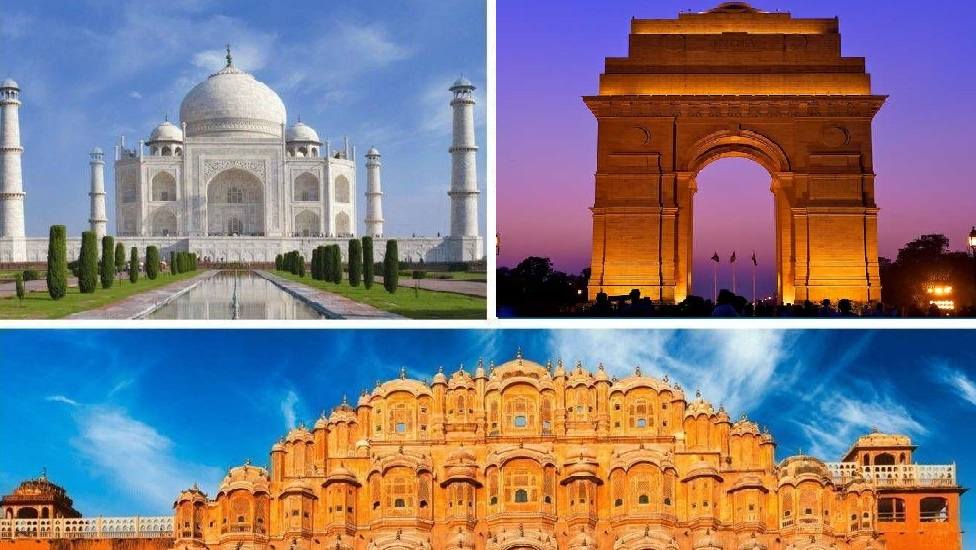India’s Golden Triangle Tour is one of the most popular routes for international travelers who want to witness the diverse cultural, architectural, and historical richness of the country. The circuit connects three major cities — Delhi, Agra, and Jaipur — forming a triangle on the map. Each city offers distinct attractions that provide valuable insight into India’s past and present. This guide highlights the key places on the Golden Triangle route that are especially admired by foreign visitors.
Delhi: A City of Living History
As the starting point for most Golden Triangle itineraries, Delhi presents a unique blend of the ancient and the modern. Among its top attractions is the Red Fort, a UNESCO World Heritage Site built in the 17th century by the Mughal emperor Shah Jahan. This fort stands as a reminder of India’s rich Mughal heritage. Not far from here, visitors can explore Jama Masjid, one of India’s largest mosques, offering panoramic views of Old Delhi from its minaret.
India Gate, dedicated to Indian soldiers who died in World War I, is another iconic site. The wide avenues surrounding it, especially Rajpath, give travelers a glimpse of British-era architecture. Travelers also enjoy visiting the Lotus Temple, notable for its unique flower-like structure and open-to-all philosophy. These monuments reflect Delhi’s layers of history and diversity, providing a strong introduction to India’s capital city.
Agra: The City of the Taj Mahal
No visit to India is complete without witnessing the Taj Mahal, one of the New Seven Wonders of the World. Built by Shah Jahan in memory of his wife Mumtaz Mahal, this marble mausoleum is celebrated for its stunning symmetry and intricate craftsmanship. The changing hues of the monument at sunrise and sunset are particularly admired by foreign tourists.
In addition to the Taj Mahal, Agra Fort draws visitors with its blend of Hindu and Mughal architectural elements. This red sandstone fortress once served as the residence of Mughal emperors. Another noteworthy spot is Mehtab Bagh, a garden complex across the Yamuna River that offers a striking view of the Taj Mahal, ideal for photography enthusiasts.
Agra provides deep insights into India’s Mughal legacy, and these historical sites are central to understanding the city’s role in India’s heritage.
Jaipur: The Pink City’s Royal Grandeur
Jaipur, also known as the Pink City, is admired for its royal architecture and vibrant culture. A key attraction here is the Amber Fort, a hilltop fort that combines Hindu and Mughal styles. Visitors can explore its grand courtyards, intricate mirror work, and panoramic views of Maota Lake below.
Another favorite stop is the City Palace, which still houses the royal family of Jaipur. The complex includes museums that display royal costumes, weapons, and artifacts. Hawa Mahal, or the Palace of Winds, is known for its ornate façade featuring 953 small windows designed for royal women to observe street festivities without being seen.
Jaipur’s colorful bazaars, such as Johari Bazaar and Bapu Bazaar, add a lively dimension to the city, making it a highlight of the Golden Triangle experience.
Ranthambore Extension: A Glimpse of India’s Wildlife
Many travelers combine their Golden Triangle journey with a wildlife experience. The Golden Triangle Tour With Ranthambore provides this opportunity by adding a stop at Ranthambore National Park. This park is known for its population of Bengal tigers and rich biodiversity. Foreign visitors often enjoy morning and evening safaris, where they can spot leopards, sloth bears, and a variety of birds alongside tigers.
Ranthambore Fort, located within the park, adds historical depth to the visit. The ruins, temples, and massive gates of the fort reflect the area’s strategic importance in Rajasthan’s history. This extension offers a balance between cultural exploration and natural adventure.
Varanasi Extension: The Spiritual Heart of India
For those interested in India’s spiritual traditions, the Golden Triangle Tour with Varanasi provides an enriching addition. Varanasi is considered one of the oldest inhabited cities in the world and holds great significance in Hinduism. The Ghats of the Ganges River, especially Dashashwamedh Ghat, attract visitors who want to witness or participate in the daily Ganga Aarti, a ritual of light and prayer.
Another important site is Kashi Vishwanath Temple, dedicated to Lord Shiva. The narrow alleys, ancient temples, and vibrant markets create an atmosphere that fascinates many foreign travelers. A boat ride on the Ganges at sunrise offers an unforgettable perspective on the city’s sacred traditions.
This extension allows visitors to experience India’s spiritual essence alongside its architectural wonders.
Final Thoughts
The Golden Triangle’s blend of history, architecture, culture, and spirituality offers foreign travelers a comprehensive introduction to India. From the grandeur of the Taj Mahal to the vibrant streets of Jaipur and the sacred rituals of Varanasi, each stop provides a unique window into the country’s rich heritage. Whether exploring forts, mosques, palaces, or natural landscapes, visitors can expect a memorable journey through some of India’s most iconic destinations.
